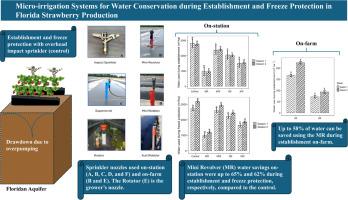Micro-irrigation systems for water conservation during establishment and freeze protection in Florida strawberry production
IF 4.2
2区 农林科学
Q1 HORTICULTURE
引用次数: 0
Abstract
Florida's annual hill system for strawberry production employs high-volume overhead sprinklers to establish bare-root strawberry transplants and to protect flowers and fruit from frost and freeze injury. Experiments were conducted to evaluate whether micro-sprinkler systems can serve as effective alternatives while conserving water. At a research farm in north-central Florida, five irrigation systems were compared for ‘Florida Brilliance’ strawberry production: an impact sprinkler system, which served as the control and four micro-irrigation systems: (1) Mini Revolver (MR), (2) SuperNet Jet (NS), (3) Mini Wobbler (MW), and (4) Xcel Wobbler (XW). The experimental design was a randomized complete block with four replications. Significant water reduction was noted when using micro-irrigation systems. The MR system used 953.13 m³/ha for establishment, which is 65 % less than the control system's 2756.82 m³/ha usage. No adverse effects were observed among the treatments regarding strawberry transplant survival, vigor, or vegetative growth. During freeze protection, the MR system used 1203.82 m³/ha compared to the impact sprinkler system, which used 3183.37 m³/ha, saving 62 % of water. When comparing the MR system with a grower’s Rotator sprinkler system on a commercial farm in west-central Florida using the Odessa and Medusa cultivars in consecutive seasons, the MR system consumed 58 % less water during establishment and 63 % less for freeze protection than the Rotator sprinkler system. The two systems showed no significant differences in transplant survival, vigor, vegetative growth, or yield. Therefore, micro-irrigation systems like the MR are viable for reducing water use during bare-root strawberry transplanting and freeze protection.

微灌系统在佛罗里达草莓生产期间的节水和冷冻保护
佛罗里达州的年度丘陵系统草莓生产采用了大量的头顶洒水装置,以建立裸根草莓移植,并保护花朵和果实免受霜冻和冻害。进行了试验,以评估微型喷水灭火系统是否可以作为节约用水的有效替代方案。在佛罗里达州中北部的一个研究农场,对“Florida Brilliance”草莓生产的五种灌溉系统进行了比较:作为控制的冲击喷灌系统和四种微灌系统:(1)Mini Revolver (MR), (2) SuperNet Jet (NS), (3) Mini Wobbler (MW)和(4)Xcel Wobbler (XW)。实验设计为随机完全区组,共4个重复。当使用微灌系统时,节水效果显著。MR系统的建立用水量为953.13 m³/ha,比控制系统的2756.82 m³/ha减少65%。在草莓移栽成活率、活力或营养生长方面,各处理均未观察到不良反应。在防冻期间,MR系统的用水量为1203.82 m³/ha,而冲击式喷水灭火系统的用水量为3183.37 m³/ha,节水62%。当将MR系统与佛罗里达州中西部一个连续使用敖德萨和美杜莎品种的商业农场的种植者旋转式喷水灭火系统进行比较时,MR系统在建立过程中消耗的水比旋转式喷水灭火系统少58%,防冻用水比旋转式喷水灭火系统少63%。两种体系在移栽成活率、活力、营养生长和产量方面均无显著差异。因此,像MR这样的微灌系统是可行的,可以减少裸根草莓移栽和冷冻保护期间的用水量。
本文章由计算机程序翻译,如有差异,请以英文原文为准。
求助全文
约1分钟内获得全文
求助全文
来源期刊

Scientia Horticulturae
农林科学-园艺
CiteScore
8.60
自引率
4.70%
发文量
796
审稿时长
47 days
期刊介绍:
Scientia Horticulturae is an international journal publishing research related to horticultural crops. Articles in the journal deal with open or protected production of vegetables, fruits, edible fungi and ornamentals under temperate, subtropical and tropical conditions. Papers in related areas (biochemistry, micropropagation, soil science, plant breeding, plant physiology, phytopathology, etc.) are considered, if they contain information of direct significance to horticulture. Papers on the technical aspects of horticulture (engineering, crop processing, storage, transport etc.) are accepted for publication only if they relate directly to the living product. In the case of plantation crops, those yielding a product that may be used fresh (e.g. tropical vegetables, citrus, bananas, and other fruits) will be considered, while those papers describing the processing of the product (e.g. rubber, tobacco, and quinine) will not. The scope of the journal includes all horticultural crops but does not include speciality crops such as, medicinal crops or forestry crops, such as bamboo. Basic molecular studies without any direct application in horticulture will not be considered for this journal.
 求助内容:
求助内容: 应助结果提醒方式:
应助结果提醒方式:


